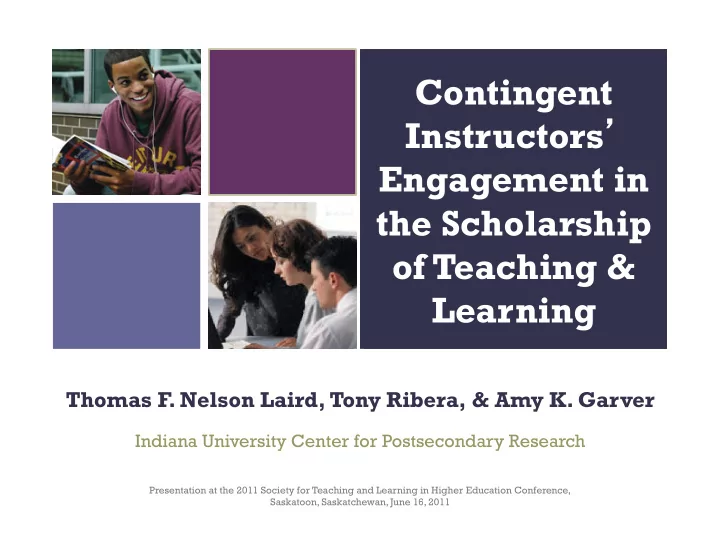

Contingent Instructors ’ Engagement in the Scholarship of Teaching & Learning Thomas F. Nelson Laird, Tony Ribera, & Amy K. Garver Indiana University Center for Postsecondary Research Presentation at the 2011 Society for Teaching and Learning in Higher Education Conference, Saskatoon, Saskatchewan, June 16, 2011
Agenda • Background of study on faculty engagement in and institutional encouragement of SoTL • Findings regarding contingent instructors ’ engagement in SoTL • Discussion of implications and future research
FSSE Background • Faculty Survey of Student Engagement (FSSE) • Annual online survey of faculty members • Baccalaureate-granting institutions • Current or prior participation in NSSE • Goal: to measure faculty perceptions of and contributions to student engagement • Survey options • Course-based questions • Typical student questions
Our Interest • Interest in faculty participation in SoTL activities and faculty perceptions of institutional encouragement • To what extent do institutions encourage faculty to engage in SoTL? • To what extent do faculty engage in SoTL? • What predicts faculty perceptions of institutional encouragement and faculty participation in SoTL?
Framework Huber & Hutchings (2005) defining features of SoTL • Questioning • Gathering and Exploring Evidence • Trying Out and Refining New Insights • Going Public
Respondents • 4,229 faculty members • From 49 U.S. Inst • 45% Women • 24% From research/doc 39% From master ’ s • 76% White 6% From bacc – arts & sci • 92% US Citizens 18%From bacc – diverse • 69% had a doctorate 12% From other • 13% PT lecturer/instructor 11% FT lecturer/instructor 28% Assistant professor • 53% From private inst 25% Associate professor 23% Full professor • Ave UG enrollment 5,800 • Discipline • 27% Arts & Hum • 7% Education • 14% Social Science • 5% Biology • 4% Engineering • 8% Professional • 10% Business • 11% Physical Sci • 13% Other
Institutional Encouragement of SoTL ( alpha = 0.87) Very Quite Very Items Little Some a Bit Much Systematically collect information about the effectiveness of their teaching beyond end-of- 27% 32% 23% 19% term course evaluations Use assessment findings to inform changes 18% 35% 28% 19% made to their courses Publicly present (e.g., lectures or workshops) 26% 39% 23% 12% information about teaching or learning Publish on teaching and learning 30% 40% 20% 11% Collaborate with colleagues on improving 18% 39% 27% 16% teaching and learning Note . Some frequency totals do not sum to 100% due to rounding.
Faculty Engagement in SoTL ( alpha = 0.83) Very Quite Very Little a Bit Much Items Some Systematically collecting information about the 16% 33% 28% 23% effectiveness of your teaching beyond end-of- term course evaluations Using assessment findings to inform changes 10% 27% 34% 28% made to your courses Publicly presenting (e.g., lectures or 42% 29% 16% 13% workshops) information about teaching or learning Publishing on teaching and learning 56% 24% 11% 10% Collaborating with colleagues on improving 15% 34% 30% 22% teaching and learning Note . Some frequency totals do not sum to 100% due to rounding.
Our Focus Today • Contingent Instructors (FT & PT Lect/Instr) • Teach many undergraduate courses • Numbers continue to increase • Effect on student learning?
Institutional Encouragement of SoTL Rank/Employment Status B Robust SE Significance Part-time lecturer reference group -0.08 0.07 Full-time lecturer -0.07 0.07 Assistant Professor -0.12 0.07 Associate Professor -0.05 0.06 Full Professor
Faculty Engagement in SoTL Rank/Employment Status B Robust SE Significance Part-time lecturer reference group 0.04 0.06 Full-time lecturer 0.13 0.06 * Assistant Professor 0.14 0.05 * Associate Professor 0.15 0.06 * Full Professor
Institutional Encouragement of SoTL PT FT Asst Assc Full Items Lect Lect Prof Prof Prof Systematically collecting information about the effectiveness of your teaching 43% 44% 40% 40% 41% beyond end-of-term course evaluations Using assessment findings to inform 49% 49% 48% 45% 47% changes made to your courses Publicly presenting (e.g., lectures or workshops) information about teaching 42% 43% 37% 31% 30% or learning Publishing on teaching and learning 36% 40% 33% 25% 25% Collaborating with colleagues on 53% 48% 45% 37% 37% improving teaching and learning Note . Percent of faculty members responding “Quite a bit” or “Very much”.
Faculty Engagement in SoTL PT FT Asst Assc Full Items Lect Lect Prof Prof Prof Systematically collecting information about the effectiveness of your teaching 53% 53% 55% 49% 49% beyond end-of-term course evaluations Using assessment findings to inform 61% 65% 67% 61% 57% changes made to your courses Publicly presenting (e.g., lectures or workshops) information about teaching 26% 25% 33% 29% 27% or learning Publishing on teaching and learning 17% 17% 23% 20% 21% Collaborating with colleagues on 50% 59% 57% 49% 45% improving teaching and learning Note . Percent of faculty members responding “Quite a bit” or “Very much”.
Implications • More faculty involved in SoTL than we suspected • Greater institutional emphasis, but results for contingent faculty suggest there may be structural issues as well (resources, policies, rewards, etc.) • Need to be sensitive to the differences between FT and PT contingent faculty Opportunities for dissemination • Look for opportunity to change • Collaboration between contingent instructors and assistant professors?
Future Research • Differences between FT and PT contingent faculty • Qualitative differences in SoTL engagement by rank and employment status • Do assessment methods, collaborators, publication outlets, etc. differ? • What factors increase faculty engagement in SoTL and how might those factors differ for contingent faculty?
Questions Thank you for participating. For more information on FSSE, visit www.fsse.iub.edu
Recommend
More recommend